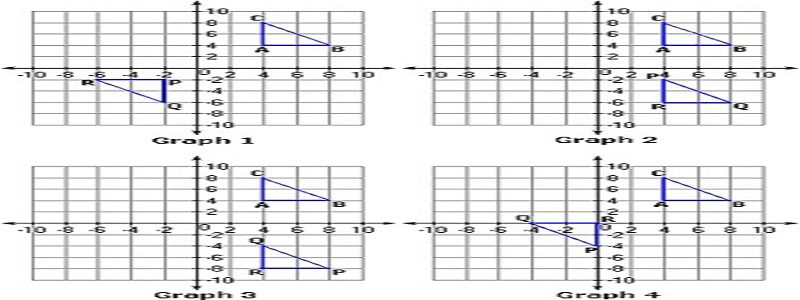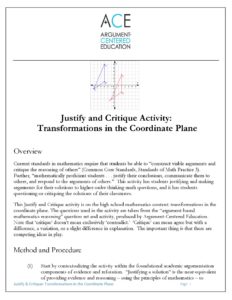
Justify & Critique on Transformations in the Coordinate Plane
Argument-Centered Education is working with partner high schools right now on implementing a variation (and somewhat of a simplification) of the Justify & Critique activity for mathematics classrooms.
This version of the argument-based activity has the same warrants for its use as were laid out in a version previously posted here in The Debatafier on algebraic relationships in two variables, and the same alignment with Common Core and NCTM standards that elevate meta-cognition, ability to communicate how math principles work in solutions, and mathematical reasoning process over product.
The method and procedure in this version is a little bit simplified. And the content on which students perform their justifications and critiques is, in this instance, the graphing and coordinate work that is encompassed by transformations in the coordinate plane.
Method and Procedure
(1)
Start by contextualizing the activity within the foundational academic argumentation components of evidence and refutation. “Justifying a solution” is the near-equivalent of providing evidence and reasoning – using the principles of mathematics – to articulate why the solution is true. “Critiquing mathematical reasoning” is doing the kind of critical thinking – note the close etymological connection – that refutation activates. Students will critique other students’ justifications, and then other students will come back to refute critiques, in this activity. In justifying their solution, students will explain and show evidence of the mathematical reasoning they used to come to their solution. In critiquing mathematical reasoning students will think critically about and evaluate the mathematical reasoning of others.
(2)
If this is the first use of an argument-based strategy this year, the teacher should consider showing one of the videos that Argument-Centered Education has collected that demonstrate what argumentation can look like in the math classroom.
(3)
Students should be put in pairs. Then each pair should be assigned another pair that they will be matched against for this activity, forming quads.
(4)
The two-person pairs of students should work on solving all of the problems below on the math content: transformations in the coordinate plane. While solving the problems they should work in pairs, not in quads.
(5)
Each pair should talk through and take notes on their justifications for their solutions, and be ready to present their justification to the class.
(6)
The first quad of four students (two pairs) should then be called up to the front of the class to conduct their justification and critique. One pair should be selected by the instructor to go first answering and justifying their answer to the first problem. Then the second pair should be asked to critique the justification presented by the first pair. The critique should address the questions:
Do you agree with the solution?
Was the justification clearly expressed?
Did the justification draw on valid mathematical principles?
Was there anything missing or inaccurate in the justification?
Can you provide a justification that would be fuller or more valid? What makes it so?
The first pair then gets a chance to respond to and (if applicable) refute the critique.
(7)
The tables are turned for the next problem. The second pair should solve this problem and justify their solution. The first pair should then critique the second pair’s justification. The second pair should (if applicable) try to refute the critique.
(8)
Student pairs should be allowed to use a document camera, under the instructor’s supervision, in order to demonstrate their work.
(9)
Each group of students should go up to the front of the class to participate in the Justify and Critique activity, in turn. Occasionally, the instructor should ask students who are observing questions to check for their understanding and to involve them in the on-going learning project.
(10)
A separate rubric can be used to assess student pairs’ justification and critique and the mathematical reasoning they conducted and communicated. Or the activity can be conducted without a formal or direct assessment component. Also, the instructor can ask students at the end of the activity to select the pair with the strongest justification of their solution, and the pair with the strongest critique of another pair’s justification, awarding bonus points to these pairs.
You can download a full version of this activity, along with 12 problems that students have to solve, and then justify and critique those solutions, on the mathematical content of transformations in the coordinate plane, by clicking on the image below:
 Happy argumentation in math! Please contact us to let us know how you are using argument in your mathematics classrooms, and how we can help you take this innovative and important professional application to the next level.
Happy argumentation in math! Please contact us to let us know how you are using argument in your mathematics classrooms, and how we can help you take this innovative and important professional application to the next level.

